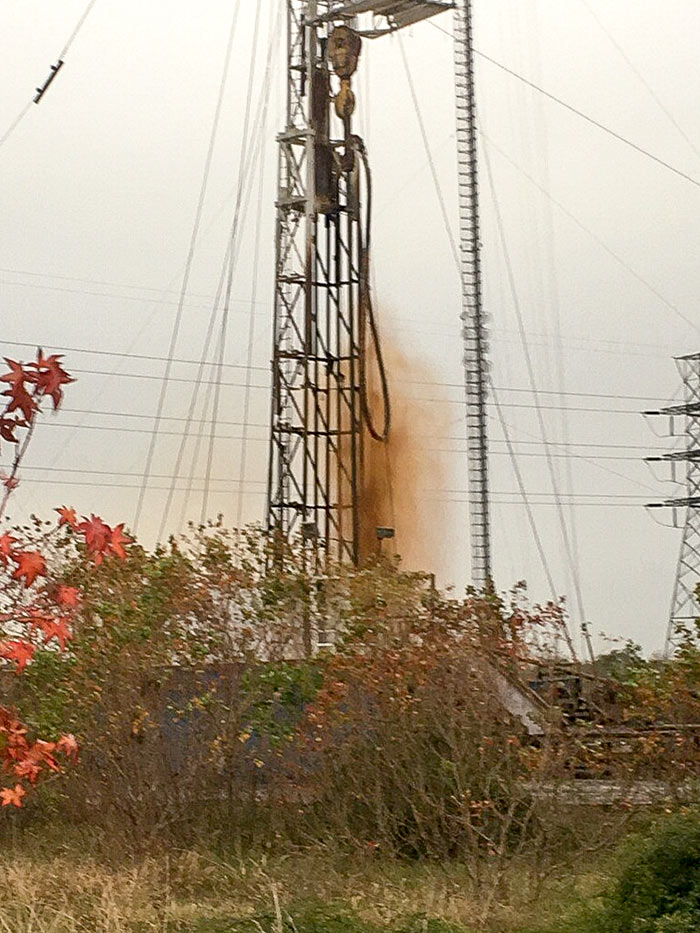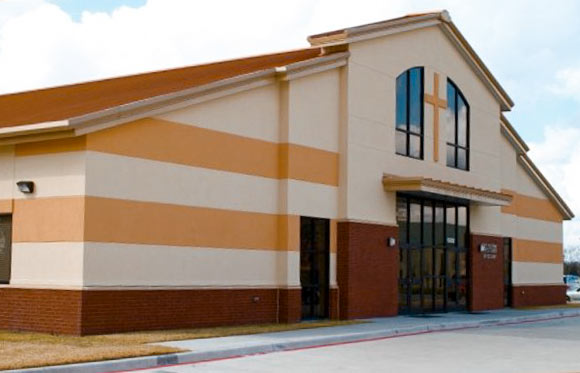AN UPDATE ON THE LEAKY OIL WELL IN MISSOURI CITY  All liquids that spewed from the oil well on McHard Rd. just west of the Fort Bend Tollway after its blow-out accident last Wednesday have been removed from the ground surrounding the facility, the Missouri City Office of Emergency Management now reports. But that’s just the wet stuff. Workers from Haz Mat Special Services have so far dug up 1,200 of an expected 5,200–7,200 yards of possibly contaminated dirt from the immediate vicinity, to be replaced with soil from somewhere else. What else can they do? “Crews have also sprayed the area to reduce the odor. Air monitoring is still on going. Crews are also trying to prep the area for the predicted rain fall the region may receive.†[Missouri City Emergency Preparedness; previously on Swamplot] Photo: Fort Bend County OEM
All liquids that spewed from the oil well on McHard Rd. just west of the Fort Bend Tollway after its blow-out accident last Wednesday have been removed from the ground surrounding the facility, the Missouri City Office of Emergency Management now reports. But that’s just the wet stuff. Workers from Haz Mat Special Services have so far dug up 1,200 of an expected 5,200–7,200 yards of possibly contaminated dirt from the immediate vicinity, to be replaced with soil from somewhere else. What else can they do? “Crews have also sprayed the area to reduce the odor. Air monitoring is still on going. Crews are also trying to prep the area for the predicted rain fall the region may receive.†[Missouri City Emergency Preparedness; previously on Swamplot] Photo: Fort Bend County OEM





I’ve got to say: What a mess. So last century.
I’m used to hearing about how oil has to pumped from the ground. I assumed the days of “Giant” were over, especially on the easily accessible land wells. Any geologist types care to educate me? Not being a jerk. I really want to know.
Blowouts still happen, yes, but they happen far less often and the cleanup response is far far more professional.
.
About that last century, just to put things in perspective…
.
Up until the 1930s, most oil taken from the ground was quite simply stored in earthen pits. Oil penetrated the soil to about 30 feet vertically and 100 feet horizontally. Humble by itself had 6,000,000 barrels of earthen pit storage. Note that the world’s largest documented land-based oilspills (not related to the Gulf War) were the Lakeview Gusher in Kern County, California (9,000 bbl) and Fergana Valley in Uzbekistan (2,090 bbl). Deepwater Horizon was the worst maritime spill (4,100-4,900 bbl). These pits are not considered spills, but the land around them is far more impacted than a spill site. Back then, when pits failed from flooding or erosion, that was often unreported.
So they’ve cleaned up the oil. They’re replacing all the dirt. They’re reducing the odor. But WHAT ABOUT THE PSYCHOLOGICAL DAMAGE?
Thanks Niche. Sounds like someone’s hunch was way too spot on. I love geology so anyone else’s opinion, especially in the field, would be greatly appreciated.
Niche – Your numbers are way off. The Macando spill was 4.9 million bbl, not 4,900 bbl.
@James Dean
The very small outfits who can make money on the dregs and leftover oil in the fields around the Houston area are not the best or most competent. They cut as many corners and use as much old and nearly broken equipment as they can to eke out a living, so these minor spills and incidents are far more common with them than it would be for a larger operator
@ JB: You are correct. Mea culpa.
Retired from oil industry. In older fields, some of the old wellbore casings have failed, allowing gas to travel up into another zone. Most of the oil fields in the gulf coast are also highly faulted, with many areas where oil and gas can travel up a fault line and get trapped in small pockets at another, strong-sealed fault. When drilling, they generally know which zones have the potential to have some of these gases, which may have built up the formation pressure. But sometimes, you hit one and can’t increase the mud weight fast enough to prevent a blowout. There was a blowout in the 1940’s in the 1960/Kuykendahl that charged a shallow fresh water zone. I remember sitting on a call with the fire dept back in the 80’s. Water well up by Hooks airport started spewing gas with the water. We were there to help Halliburton cap and plug the well and make sure no fire started.